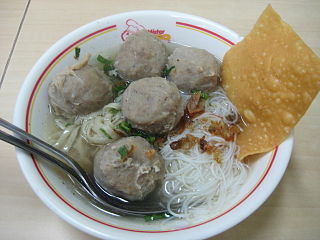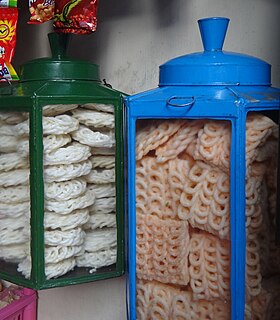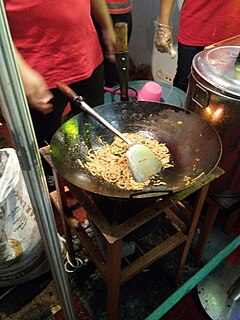
Chinese Indonesian cuisine is characterized by the mixture of Chinese with local Indonesian style. Chinese Indonesians, mostly descendant from Hokkien, brought their legacy of Chinese cuisine, and modified some of the dishes with the addition of Indonesian ingredients, such as kecap manis, palm sugar, peanut sauce, chili, santan and local spices to form a hybrid Chinese-Indonesian cuisine. Some of the dishes and cakes share the same style as in Malaysia and Singapore which are known as the Nonya cuisine by the Peranakan.

Fried noodles are common throughout East Asia, Southeast Asia and South Asia. Many varieties, cooking styles, and ingredients exist.

Mie kuah, literally "noodle soup", or also known as mie rebus/mi rebus or mee rebus, literally "boiled noodles", is an Indonesian noodle soup dish, and popular in Maritime Southeast Asia countries such as Malaysia, and Singapore.

Bakmi consists of two Hokkien Chinese words literally translated to English as "meat noodles". Bakmi is a wheat based noodle which was brought to Indonesian Archipelago by Hokkien Chinese immigrants from Fujian, generally prepared and topped with minced pork seasoned in soy sauce and A few slices of char siu (叉燒) or barbecued pork, with addition of Chinese green vegetables and a bowl of broth.

Mie goreng, also known as bakmi goreng, is an Indonesian style of often spicy fried noodle dish, common in Indonesia and has spread to Malaysia, Singapore, and Brunei Darussalam. It is made with thin yellow noodles stir fried in cooking oil with garlic, onion or shallots, fried prawn, chicken, beef, or sliced bakso (meatballs), chili, Chinese cabbage, cabbages, tomatoes, egg, and other vegetables.

Indomie is a brand of instant noodle produced by the Indonesian company Indofood. Indofood itself is the largest instant noodle producer in the world, with 16 factories, 15 billion packets of Indomie are produced annually. Indomie is also exported to more than 60 countries around the world. Indofood's key export markets include Australia, India, Iraq, Papua New Guinea, Hong Kong, East Timor, Jordan, Saudi Arabia, the United States, New Zealand, Taiwan, and other countries in Europe, Africa, the Middle East and Asia. Outside its main manufacturing plants in Indonesia, Indomie has been produced in Nigeria since 1995 where it is a popular brand. Indofood has the largest instant noodle manufacturing plant in Africa.

Bakso or baso is an Indonesian meatball, or a meat paste made from beef surimi. Its texture is similar to the Chinese beef ball, fish ball, or pork ball. The word bakso may refer to a single meatball or the complete dish of meatball soup. Mie bakso refers to bakso served with yellow noodles and rice vermicelli, while bakso kuah refers to bakso soup served without noodles.

Dried shrimp are shrimp that have been sun-dried and shrunk to a thumbnail size. They are used in many East Asian, Southeast Asian and South Asian cuisines, imparting a unique umami taste. A handful of shrimp is generally used for dishes. The flavors of this ingredient are released when allowed to simmer.

Mie celor, is a Southeast Asian noodle soup dish served in a coconut milk and shrimp-based broth, specialty of Palembang city, South Sumatra, Indonesia.

Kwetiau goreng is a Chinese Indonesian stir fried flat rice noodle dish from Indonesia and popular in Southeast Asia. This flavorful and spicy fried noodle dish is common in Indonesia. It is made from noodles, locally known as kwetiau, which are stir fried in cooking oil with garlic, onion or shallots, beef, chicken, fried prawn, crab or sliced bakso (meatballs), chili, Chinese cabbage, cabbages, tomatoes, egg, and other vegetables with an ample amount of kecap manis. In Asia, kwetiau is available in two forms, dried and fresh. Its recipe is quite similar to another Chinese Indonesian favourite, mie goreng, with the exception of replacing yellow wheat noodles for flat rice noodles.

Mie ayam, mi ayam or bakmi ayam is a common Indonesian dish of seasoned yellow wheat noodles topped with diced chicken meat (ayam). It especially common in Indonesia, Singapore and Malaysia, and can trace its origin to Chinese cuisine. In Indonesia, the dish is recognized as a popular Chinese Indonesian dish, served from simple travelling vendor carts frequenting residential areas, humble street-side warung to restaurants.

Mie aceh or mi aceh is an Acehnese curried spicy noodle dish.

Krupuk or kerupuk (Indonesian) or kroepoek (Dutch) is an Indonesian deep fried cracker made from starch and other ingredients that serve as flavouring. They are a popular snack in parts of Southeast Asia, but most closely associated with Indonesia. Kroepoek also can be found in the Netherlands, through their historic colonial ties with Indonesia.

Mie jawa, also called as mi jawa or bakmi jawa in Indonesia, or mee Jawa in Malaysia is a traditional Indonesian–Javanese style noodle, commonly found in Indonesia and Malaysia. The dish is made of yellow noodle, chicken, vegetables, egg and spices. The recipe however, is slightly different between mie jawa in Indonesia and mee Jawa in Malaysia.

Ifumi is an Indonesian crispy deep fried thick noodle dish, popular in Maritime Southeast Asia, served in a thick savoury sauce with pieces of meat or seafood and vegetables. The dishes are to be served hot while the noodles are still crisp until the noodles are softened by the sauce and are ready to be eaten. The dish is one of the most popular noodle dishes in Chinese Indonesian cuisine. The type of noodle being used in this dish is the thick yi mein noodle, hence the origin of its name. It is quite similar to mie kering noodles from Makassar.

Makassarese cuisine is the cuisine of Makassarese people of Makassar in the South Sulawesi province of Indonesia.

Kwetiau ayam, kuetiau ayam or sometimes kwetiau ayam kuah is a common Chinese Indonesian dish of seasoned flat rice noodles topped with diced chicken meat (ayam). It is often described as a kwetiau version of the popular mie ayam, and especially common in Indonesia, and can trace its origin to Chinese cuisine.

Indonesian noodles are a significant aspect of Indonesian cuisine which is very diverse. Indonesian cuisine recognised many types of noodles, with each regions often developed their distinct recipes.

















